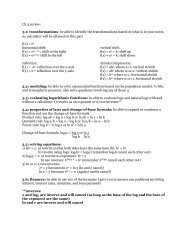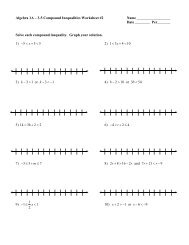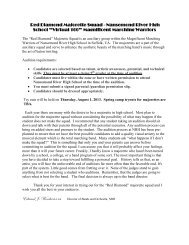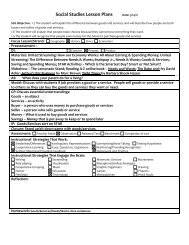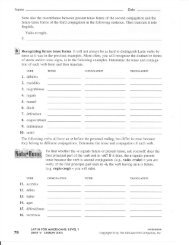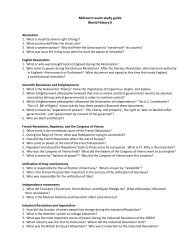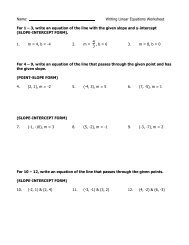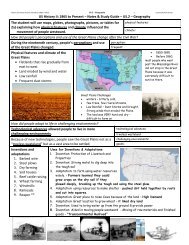The Federalists in Power and the Emergence of a Two-Party System
The Federalists in Power and the Emergence of a Two-Party System
The Federalists in Power and the Emergence of a Two-Party System
- No tags were found...
You also want an ePaper? Increase the reach of your titles
YUMPU automatically turns print PDFs into web optimized ePapers that Google loves.
elieved <strong>in</strong> a weak national government <strong>and</strong> strong state governments. <strong>The</strong>y also favored <strong>the</strong> development <strong>of</strong> anagricultural economy based on farm<strong>in</strong>g <strong>and</strong> a close relationship between <strong>the</strong> United States <strong>and</strong> France. Farmers, artisans(skilled craftsmen), <strong>and</strong> frontier settlers <strong>in</strong> <strong>the</strong> South supported <strong>the</strong> Democratic-Republican <strong>Party</strong>.Alex<strong>and</strong>er Hamilton <strong>and</strong> John Adams led <strong>the</strong> Federalist <strong>Party</strong>. Because <strong>the</strong> <strong>Federalists</strong> believed <strong>in</strong> looseconstruction <strong>of</strong> <strong>the</strong> Constitution, <strong>the</strong>y believed <strong>in</strong> a strong national government <strong>and</strong> a national bank. S<strong>in</strong>ce <strong>the</strong>y als<strong>of</strong>avored <strong>the</strong> development <strong>of</strong> a commercial economy based on manufactur<strong>in</strong>g <strong>and</strong> trade, bankers <strong>and</strong> bus<strong>in</strong>ess <strong>in</strong>terests <strong>in</strong><strong>the</strong> Nor<strong>the</strong>ast generally supported <strong>the</strong> <strong>Federalists</strong>. <strong>The</strong> <strong>Federalists</strong> also wanted <strong>the</strong> United States to have a closerelationship with Great Brita<strong>in</strong>. This attitude toward Great Brita<strong>in</strong> led <strong>the</strong> <strong>Federalists</strong> to support <strong>the</strong> controversial JayTreaty, which <strong>the</strong> Wash<strong>in</strong>gton adm<strong>in</strong>istration negotiated (worked out) <strong>in</strong> 1794. <strong>The</strong> Jay Treaty aimed at settl<strong>in</strong>gcommercial (trade) <strong>and</strong> boundary disputes between <strong>the</strong> United States <strong>and</strong> Great Brita<strong>in</strong>. Under <strong>the</strong> most importantprovision (part) <strong>of</strong> this treaty, Great Brita<strong>in</strong> agreed to evacuate its forts <strong>in</strong> <strong>the</strong> Ohio Valley <strong>and</strong> retreat to <strong>the</strong> boundary l<strong>in</strong>eagreed upon by <strong>the</strong> two nations at <strong>the</strong> end <strong>of</strong> <strong>the</strong> Revolutionary War.John Adams won election as President at <strong>the</strong> end <strong>of</strong> Wash<strong>in</strong>gton’s second term. At this time, France was at warwith o<strong>the</strong>r European nations. Dur<strong>in</strong>g Adams’ presidency, <strong>the</strong> French conducted attacks on American shipp<strong>in</strong>g that was<strong>in</strong>volved <strong>in</strong> trade with France’s European enemies. Although a Federalist, President Adams resisted pressure fromHamilton <strong>and</strong> o<strong>the</strong>r Federalist leaders to declare war on France. Instead, Adams pursued an undeclared naval war onFrance, until a new government came to power <strong>in</strong> France <strong>and</strong> agreed to respect <strong>the</strong> neutrality <strong>of</strong> American ships.<strong>The</strong>reby, President John Adams both ma<strong>in</strong>ta<strong>in</strong>ed peace <strong>and</strong> preserved <strong>the</strong> honor <strong>of</strong> <strong>the</strong> United States. However, Adams’refusal to declare war on France also weakened his popularity among many members <strong>of</strong> <strong>the</strong> <strong>Federalists</strong>, his own politicalparty.Shortly before he left <strong>of</strong>fice, President Adams appo<strong>in</strong>ted John Marshall, a Federalist from Virg<strong>in</strong>ia, as ChiefJustice <strong>of</strong> <strong>the</strong> United States Supreme Court. For <strong>the</strong> next three decades Marshall presided over <strong>the</strong> Supreme Court, whichmade several key decisions under his leadership. Under Marshall’s leadership, <strong>the</strong> Supreme Court issued severalimportant rul<strong>in</strong>gs, which established <strong>the</strong> power <strong>of</strong> <strong>the</strong> federal courts as an <strong>in</strong>dependent <strong>and</strong> equal branch <strong>of</strong> <strong>the</strong> UnitedStates government. In <strong>the</strong> case <strong>of</strong> Marbury v. Madison <strong>the</strong> Supreme Court declared a federal law unconstitutional. Thisdecision set precedent for <strong>the</strong> federal courts to exercise judicial review. A precedent is an example for future action, <strong>and</strong>judicial review is <strong>the</strong> power to declare laws unconstitutional. By declar<strong>in</strong>g a federal law unconstitutional <strong>in</strong> <strong>the</strong> case <strong>of</strong>Marbury v. Madison, <strong>the</strong> Marshall court set <strong>the</strong> example for <strong>the</strong> future that <strong>the</strong> Supreme Court could declare o<strong>the</strong>r federallaws unconstitutional. <strong>The</strong> right <strong>of</strong> judicial review provides <strong>the</strong> Supreme Court with its ma<strong>in</strong> check on <strong>the</strong> power <strong>of</strong> <strong>the</strong>legislative branch.In McCulloch v. Maryl<strong>and</strong>, a second major decision, <strong>the</strong> Marshall Court fur<strong>the</strong>r established <strong>the</strong> power <strong>of</strong> <strong>the</strong>federal government over <strong>the</strong> states by sett<strong>in</strong>g forth <strong>the</strong> doctr<strong>in</strong>e <strong>of</strong> implied powers. In 1816, Congress chartered <strong>The</strong>Second Bank <strong>of</strong> <strong>the</strong> United States. <strong>Two</strong> years later <strong>the</strong> state <strong>of</strong> Maryl<strong>and</strong> passed legislation to levy (place) taxes on <strong>the</strong>bank. <strong>The</strong> cashier <strong>of</strong> <strong>the</strong> Baltimore branch <strong>of</strong> <strong>the</strong> bank, refused to pay this tax. <strong>The</strong> case presented two questions: DidCongress have <strong>the</strong> authority to establish <strong>the</strong> bank? Did <strong>the</strong> Maryl<strong>and</strong> law unconstitutionally <strong>in</strong>terfere with congressionalpowers? In a unanimous decision, <strong>the</strong> Court held that Congress had <strong>the</strong> power to <strong>in</strong>corporate (create) <strong>the</strong> bank <strong>and</strong> thatMaryl<strong>and</strong> could not tax <strong>in</strong>struments <strong>of</strong> <strong>the</strong> national government, which carried out constitutional powers. Writ<strong>in</strong>g for <strong>the</strong>Court, Chief Justice Marshall noted that Congress possessed implied powers that <strong>the</strong> Constitution did not specificallymention. Marshall also held that while <strong>the</strong> states reta<strong>in</strong>ed <strong>the</strong> power <strong>of</strong> taxation, "<strong>the</strong> Constitution <strong>and</strong> <strong>the</strong> laws made <strong>in</strong>pursuance <strong>the</strong>re<strong>of</strong> are supreme . . . <strong>the</strong>y control <strong>the</strong> constitution <strong>and</strong> laws <strong>of</strong> <strong>the</strong> respective states." <strong>The</strong>reby, Chief JusticeMarshall prohibited <strong>the</strong> states from tax<strong>in</strong>g agencies <strong>of</strong> <strong>the</strong> federal government by declar<strong>in</strong>g that <strong>the</strong> Maryl<strong>and</strong> state law <strong>in</strong>question was unconstitutional. Marshall, who believed it was very important for <strong>the</strong> federal government to be morepowerful than <strong>the</strong> state governments, wrote, “<strong>The</strong> power to tax is <strong>the</strong> power to destroy.” In addition, s<strong>in</strong>ce McCulloch v.Maryl<strong>and</strong> declared a state law unconstitutional, it streng<strong>the</strong>ned <strong>the</strong> federal court’s power <strong>of</strong> judicial review.F<strong>in</strong>ally, John Marshall set forth a broadly national view <strong>of</strong> economic affairs <strong>in</strong> <strong>the</strong> Court’s 1824 decision <strong>in</strong>Gibbons v. Ogden. This case <strong>in</strong>volved <strong>the</strong> state <strong>of</strong> New York’s regulations for steamboats, which did bus<strong>in</strong>ess betweenNew York <strong>and</strong> New Jersey. <strong>The</strong> Supreme Court ruled <strong>in</strong> this case that <strong>the</strong> federal government had complete control over<strong>in</strong>terstate commerce (trade between states). By <strong>the</strong>se <strong>and</strong> o<strong>the</strong>r decisions, Chief Justice John Marshall contributed greatlyto <strong>the</strong> growth <strong>of</strong> <strong>the</strong> U.S. Supreme Court’s importance <strong>in</strong> relation to <strong>the</strong> o<strong>the</strong>r branches <strong>of</strong> <strong>the</strong> national government. By<strong>the</strong> doctr<strong>in</strong>e <strong>of</strong> judicial review (Marbury v. Madison), <strong>the</strong> doctr<strong>in</strong>e <strong>of</strong> implied powers (McCulloch v. Maryl<strong>and</strong>), <strong>and</strong> anexpansive national view <strong>of</strong> economic matters (Gibbons v. Ogden), <strong>the</strong> Marshall Court provided <strong>the</strong> foundation blocks <strong>of</strong><strong>the</strong> Supreme Court’s authority to mediate (settle) disagreements between branches <strong>of</strong> governments, levels <strong>of</strong> government(state <strong>and</strong> federal), <strong>and</strong> compet<strong>in</strong>g bus<strong>in</strong>ess <strong>in</strong>terests.2VA/US History Narrative 5





